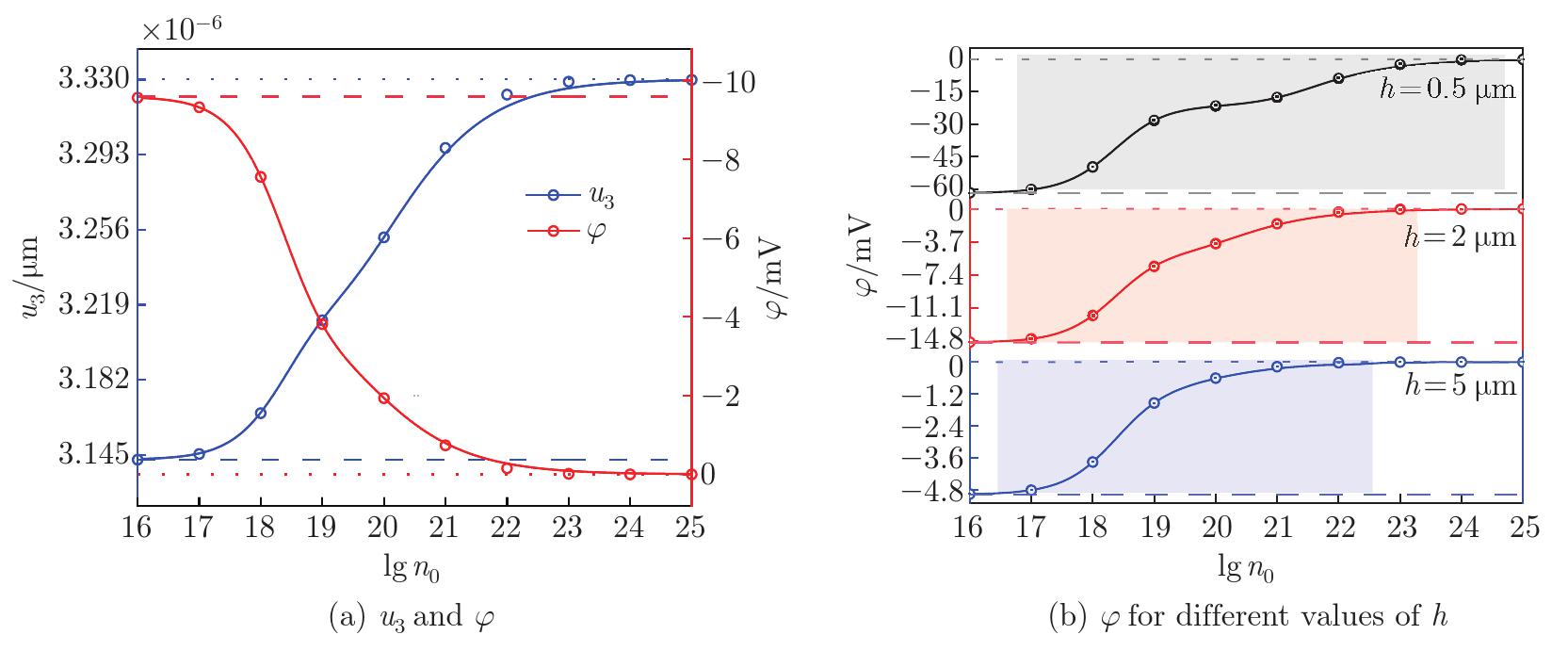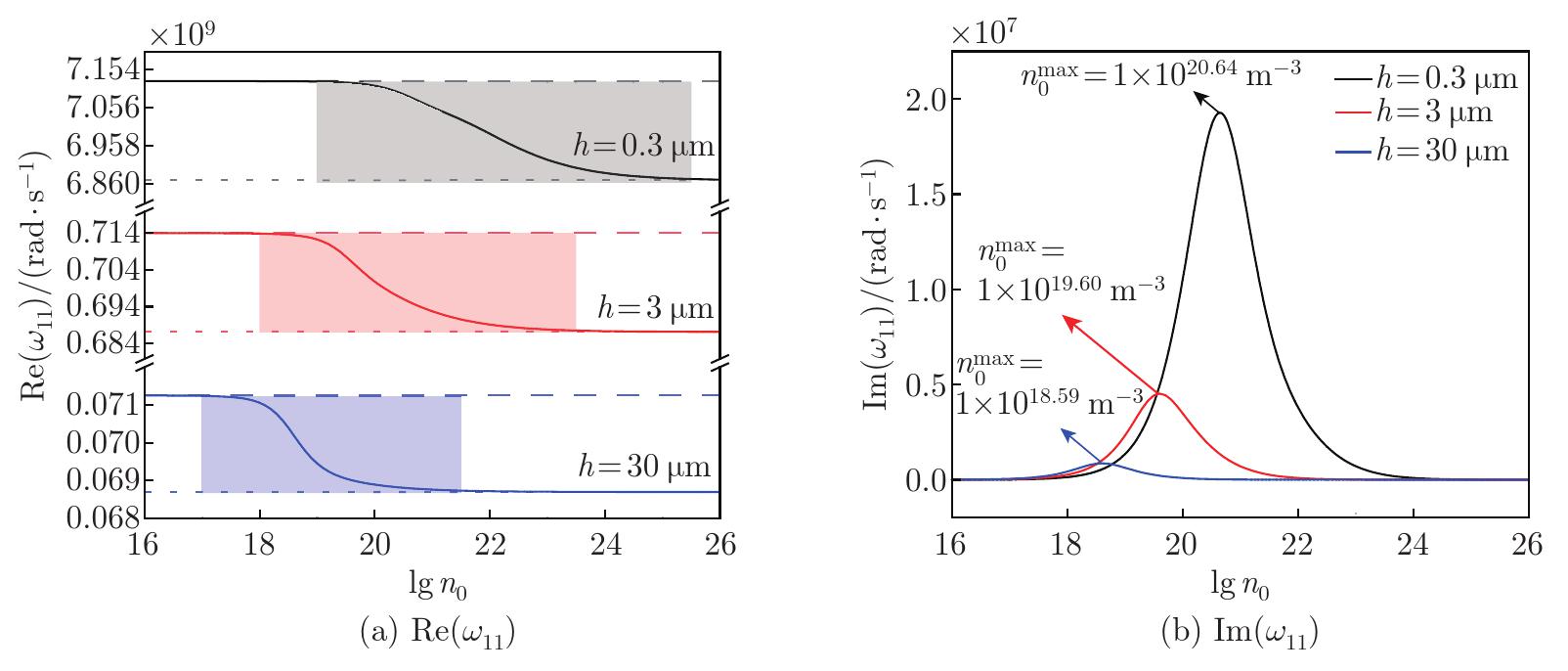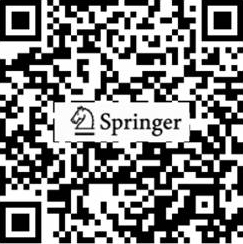Applied Mathematics and Mechanics (English Edition) ›› 2025, Vol. 46 ›› Issue (7): 1331-1346.doi: https://doi.org/10.1007/s10483-025-3272-7
Previous Articles Next Articles
Lele ZHANG1,2, Zheng ZHAO2, Xiaofan HU2, Guoquan NIE1, Jinxi LIU1,†( )
)
Received:2025-01-15
Revised:2025-05-20
Published:2025-06-30
Contact:
Jinxi LIU, E-mail: liujx02@hotmail.comSupported by:2010 MSC Number:
Lele ZHANG, Zheng ZHAO, Xiaofan HU, Guoquan NIE, Jinxi LIU. Exact multi-field coupling modeling and analysis of piezoelectric semiconductor plates. Applied Mathematics and Mechanics (English Edition), 2025, 46(7): 1331-1346.

Fig. 3
Variation of mechanical displacement u3 and electric potential φ with initial electron concentration. The dashed line and dotted line denote the results corresponding to a purely piezoelectric plate and a purely elastic plate, respectively. The circle denotes the results computed by the COMSOL Multiphysics software (color online)"


Fig. 9
Variation of natural frequency Re(ω11) and damping factor Im(ω11) with initial electron concentration. The plate thickness varies under a fixed span-to-thickness ratio η=3. The dashed line and dotted line denote the results corresponding to a purely piezoelectric plate and a purely elastic plate, respectively (color online)"

| [1] | HUTSON, A. R. Piezoelectricity and conductivity in ZnO and CdS. Physical Review Letters, 4, 505–507 (1960) |
| [2] | FAN, J. C., SREEKANTH, K. M., XIE, Z., CHANG, S. L., and RAO, K. V. p-type ZnO materials: theory, growth, properties and devices. Progress in Materials Science, 58(6), 874–985 (2013) |
| [3] | TEO, K. H., ZHANG, Y. H., CHOWDHURY, N., RAKHEJA, S., MA, R., XIE, Q. Y., YAGYU, E., YAMANAKA, K., LI, K. X., and PALACIOS, T. Emerging GaN technologies for power, RF, digital, and quantum computing applications: recent advances and prospects. Journal of Applied Physics, 130(16), 160902 (2021) |
| [4] | YANG, Q., WANG, W. H., XU, S., and WANG, Z. L. Enhancing light emission of ZnO microwire-based diodes by piezo-phototronic effect. Nano Letters, 11(9), 4012–4017 (2011) |
| [5] | ZHOU, J., GU, Y. D., FEI, P., MAI, W. J., GAO, Y. F., YANG, R. S., BAO, G., and WANG, Z. L. Flexible piezotronic strain sensor. Nano Letters, 8(9), 3035–3040 (2008) |
| [6] | HICKERNELL, F. S. The piezoelectric semiconductor and acoustoelectronic device development in the sixties. IEEE Transactions on Ultrasonics, Ferroelectrics, and Frequency Control, 52(5), 737–745 (2005) |
| [7] | HE, F., LI, W. Q., LIU, B. B., ZHONG, Y., JIN, Q. F., and QIN, X. J. Progress of piezoelectric semiconductor nanomaterials in sonodynamic cancer therapy. ACS Biomaterials Science & Engineering, 10(1), 298–312 (2023) |
| [8] | WANG, L. F. and WANG, Z. L. Advances in piezotronic transistors and piezotronics. Nano Today, 37, 101108 (2021) |
| [9] | ROZAS, G., PASCUAL WINTER, M. F., FAINSTEIN, A., JUSSERAND, B., VACCARO, P. O., SARAVANAN, S., and SAITO, N. Piezoelectric semiconductor acoustic cavities. Physical Review B, 72(3), 035331 (2005) |
| [10] | VOON, L. C. L. Y. and WILLATZEN, M. Electromechanical phenomena in semiconductor nanostructures. Journal of Applied Physics, 109(3), 031101 (2011) |
| [11] | YANG, J. S. Analysis of Piezoelectric Semiconductor Structures, Springer Nature, Switzerland (2020) |
| [12] | WANG, Z. L. and WU, W. Z. Piezotronics and piezo-phototronics: fundamentals and applications. National Science Review, 1(1), 62–90 (2014) |
| [13] | WANG, Z. L., ZHANG, Y., and HU, W. G. Piezotronics and Piezo-phototronics, Springer, Berlin (2012) |
| [14] | LI, P., JIN, F., and MA, J. X. One-dimensional dynamic equations of a piezoelectric semiconductor beam with a rectangular cross section and their application in static and dynamic characteristic analysis. Applied Mathematics and Mechanics (English Edition), 39(5), 685–702 (2018) https://doi.org/10.1007/s10483-018-2325-6 |
| [15] | ZHANG, C. L., WANG, X. Y., CHEN, W. Q., and YANG, J. S. Bending of a cantilever piezoelectric semiconductor fiber under an end force. Generalized Models and Non-classical Approaches in Complex Materials, Springer, 261–278 (2018) |
| [16] | LIANG, Y. X., YANG, W. L., and YANG, J. S. Transient bending vibration of a piezoelectric semiconductor nanofiber under a suddenly applied shear force. Acta Mechanica Solida Sinica, 32, 688–697 (2019) |
| [17] | LUO, Y. X., ZHANG, C. L., CHEN, W. Q., and YANG, J. S. Piezotronic effect of a thin film with elastic and piezoelectric semiconductor layers under a static flexural loading. Journal of Applied Mechanics, 86(5), 051003 (2019) |
| [18] | QU, Y. L., JIN, F., and YANG, J. S. Stress-induced electric potential barriers in thickness-stretch deformations of a piezoelectric semiconductor plate. Acta Mechanica, 232, 4533–4543 (2021) |
| [19] | CAO, Y., GUO, Z. W., and QU, Y. L. Static bending and forced vibration analyses of a piezoelectric semiconductor cylindrical shell within first-order shear deformation theory. Applied Mathematical Modelling, 126, 625–645 (2024) |
| [20] | WANG, T. Y., ZHU, F., LI, P., XU, Z. L., MA, T. F., KUZNETSOVA, I., and QIAN, Z. H. Analysis and modeling of two-dimensional piezoelectric semiconductor shell theory. European Journal of Mechanics-A/Solids, 106, 105331 (2024) |
| [21] | GUO, Z. W., CHEN, J. B., ZHANG, G. Y., MI, C. W., and QU, Y. L. Exact solutions for plane stress problems of piezoelectric semiconductors: tuning free-carrier motions by various mechanical loadings. European Journal of Mechanics-A/Solids, 101, 105073 (2023) |
| [22] | ZHU, J. Y., NEGAHBAN, M., XU, J., XIA, R. Y., and LI, Z. Theoretical analysis of piezoelectric semiconductor thick plates with periodic boundary conditions. Micromachines, 14(12), 2174 (2023) |
| [23] | PAN, E. N. and CHEN, W. Q. Static Green's Functions in Anisotropic Media, Cambridge University Press, New York (2015) |
| [24] | KUO, H. Y., SHIH, C. L., and PAN, E. N. Enhancing magnetoelectric effect in magneto-electro-elastic laminated composites via interface modulus and stress. International Journal of Solids and Structures, 195, 66–73 (2020) |
| [25] | TIAN, R., LIU, J. X., PAN, E. N., WANG, Y. S., and SOH, A. K. Some characteristics of elastic waves in a piezoelectric semiconductor plate. Journal of Applied Physics, 126(12), 125701 (2019) |
| [26] | HUTSON, A. R. and WHITE, D. L. Elastic wave propagation in piezoelectric semiconductors. Journal of Applied Physics, 33, 40–47 (1962) |
| [27] | WHITE, D. L. Amplification of ultrasonic waves in piezoelectric semiconductors. Journal of Applied Physics, 33, 2547–2554 (1962) |
| [28] | TING, T. C. T. Anisotropic Elasticity, Oxford University Press, New York (1996) |
| [29] | PAN, E. Exact solution for simply supported and multilayered magneto-electro-elastic plates. Journal of Applied Mechanics, 68(4), 608–618 (2001) |
| [30] | PAN, E. and HEYLIGER, P. R. Free vibrations of simply supported and multilayered magneto-electro-elastic plates. Journal of Sound and Vibration, 252(3), 429–442 (2002) |
| [31] | VATTRÉ, A. and PAN, E. Dislocation singularities in layered magneto-electro-elastic plates. International Journal of Engineering Science, 181, 103765 (2022) |
| [32] | KUO, H. Y. and CHUNG, C. Y. Multiferroic laminated composites with interfacial imperfections and the nonlocal effect. Composite Structures, 287, 115235 (2022) |
| [33] | STROH, A. N. Dislocations and cracks in anisotropic elasticity. Philosophical Magazine, 3(30), 625–646 (1958) |
| [34] | HUANG, H. Y., ZHU, F., ZHU, J. Q., WANG, B., and QIAN, Z. H. A general approach for dispersion relations in multilayered structures with an arbitrary number of piezoelectric layers and elastic layers. Acta Mechanica, 231, 489–502 (2020) |
| [35] | PAN, E. and HEYLIGER, P. R. Exact solutions for magneto-electro-elastic laminates in cylindrical bending. International Journal of Solids and Structures, 40(24), 6859–6876 (2003) |
| [36] | HE, Q. L., ZHU, C. S., HAN, B. H., FANG, X. Q., and LIU, J. X. Size-dependent free vibration of piezoelectric semiconductor plate. Acta Mechanica, 234(10), 4821–4836 (2023) |
| [37] | ZHANG, Q. Y., LI, M. E., and ZHAO, M. H. Dynamic analysis of a piezoelectric semiconductor nanoplate with surface effect. Materials Today Communications, 33, 104406 (2022) |
| [38] | LI, M. G., ZHANG, Q. Y., WANG, B. B., and ZHAO, M. H. Analysis of flexural vibrations of a piezoelectric semiconductor nanoplate driven by a time-harmonic force. Materials, 14(14), 3926 (2021) |
| [39] | FANG, X. Q., HE, Q. L., MA, H. W., and ZHU, C. S. Multi-field coupling and free vibration of a sandwiched functionally-graded piezoelectric semiconductor plate. Applied Mathematics and Mechanics (English Edition), 44(8), 1351–1366 (2023) https://doi.org/10.1007/s10483-023-3017-6 |
| [40] | QU, Y. L., JIN, F., and YANG, J. S. Buckling of a Reissner-Mindlin plate of piezoelectric semiconductors. Meccanica, 57(11), 2797–2807 (2022) |
| [41] | HEYLIGER, P. R., RAMIREZ, F., and PAN, E. Two-dimensional static fields in magnetoelectroelastic laminates. Journal of Intelligent Material Systems and Structures, 15, 689–709 (2004) |
| [42] | GUO, J. Y., NIE, G. Q., LIU, J. X., and ZHANG, L. L. Free vibration of a piezoelectric semiconductor plate. European Journal of Mechanics-A/Solids, 95, 104647 (2022) |
| [1] | Yansong LI, Wenjie FENG, Lei WEN. Free vibration of piezoelectric semiconductor composite structure with fractional viscoelastic layer [J]. Applied Mathematics and Mechanics (English Edition), 2025, 46(4): 683-698. |
| [2] | Jufang JIA, Huilin YIN, Qinyu YU, Jiabin SUN, Xinsheng XU, Zhenhuan ZHOU. New analytical solutions for free vibration of embedded magneto-electro-elastic cylindrical shells with step-wise thickness variations [J]. Applied Mathematics and Mechanics (English Edition), 2025, 46(3): 447-466. |
| [3] | Jie CHEN, Xinyue ZHANG, Mingyang FAN. Dynamic behaviors of graphene platelets-reinforced metal foam piezoelectric beams with velocity feedback control [J]. Applied Mathematics and Mechanics (English Edition), 2025, 46(1): 63-80. |
| [4] | Wei CHEN, Zhihong TANG, Yufen LIAO, Linxin PENG. A six-variable quasi-3D isogeometric approach for free vibration of functionally graded graphene origami-enabled auxeticmetamaterial plates submerged in a fluid medium [J]. Applied Mathematics and Mechanics (English Edition), 2025, 46(1): 157-176. |
| [5] | Xiaoyang SU, Tong HU, Wei ZHANG, Houjun KANG, Yunyue CONG, Quan YUAN. Transfer matrix method for free and forced vibrations of multi-level functionally graded material stepped beams with different boundary conditions [J]. Applied Mathematics and Mechanics (English Edition), 2024, 45(6): 983-1000. |
| [6] | S. JAHANGIRI, A. GHORBANPOUR ARANI, Z. KHODDAMI MARAGHI. Dynamics of a rotating ring-stiffened sandwich conical shell with an auxetic honeycomb core [J]. Applied Mathematics and Mechanics (English Edition), 2024, 45(6): 963-982. |
| [7] | H.M. FEIZABAD, M.H. YAS. Free vibration and buckling analysis of polymeric composite beams reinforced by functionally graded bamboo fibers [J]. Applied Mathematics and Mechanics (English Edition), 2024, 45(3): 543-562. |
| [8] | Xiaodong GUO, Zhu SU, Lifeng WANG. Dynamic characteristics of multi-span spinning beams with elastic constraints under an axial compressive force [J]. Applied Mathematics and Mechanics (English Edition), 2024, 45(2): 295-310. |
| [9] | Zhi LI, Cuiying FAN, Mingkai GUO, Guoshuai QIN, Chunsheng LU, Dongying LIU, Minghao ZHAO. Natural frequency analysis of laminated piezoelectric beams with arbitrary polarization directions [J]. Applied Mathematics and Mechanics (English Edition), 2024, 45(11): 1949-1964. |
| [10] | Xueqian FANG, Qilin HE, Hongwei MA, Changsong ZHU. Multi-field coupling and free vibration of a sandwiched functionally-graded piezoelectric semiconductor plate [J]. Applied Mathematics and Mechanics (English Edition), 2023, 44(8): 1351-1366. |
| [11] | Youqi ZHANG, Rongyu XIA, Jie XU, Kefu HUANG, Zheng LI. Theoretical analysis of surface waves in piezoelectric medium with periodic shunting circuits [J]. Applied Mathematics and Mechanics (English Edition), 2023, 44(8): 1287-1304. |
| [12] | Xiaoyu FU, Xiang MU, Jinming ZHANG, Liangliang ZHANG, Yang GAO. Green’s functions of two-dimensional piezoelectric quasicrystal in half-space and bimaterials [J]. Applied Mathematics and Mechanics (English Edition), 2023, 44(2): 237-254. |
| [13] | U. N. ARIBAS, M. AYDIN, M. ATALAY, M. H. OMURTAG. Cross-sectional warping and precision of the first-order shear deformation theory for vibrations of transversely functionally graded curved beams [J]. Applied Mathematics and Mechanics (English Edition), 2023, 44(12): 2109-2138. |
| [14] | Changsong ZHU, Xueqian FANG, Jinxi LIU. Nonlinear free vibration of piezoelectric semiconductor doubly-curved shells based on nonlinear drift-diffusion model [J]. Applied Mathematics and Mechanics (English Edition), 2023, 44(10): 1761-1776. |
| [15] | Lingkang ZHAO, Peijun WEI, Yueqiu LI. Free vibration of thermo-elastic microplate based on spatiotemporal fractional-order derivatives with nonlocal characteristic length and time [J]. Applied Mathematics and Mechanics (English Edition), 2023, 44(1): 109-124. |
| Viewed | ||||||
|
Full text |
|
|||||
|
Abstract |
|
|||||


 Email Alert
Email Alert RSS
RSS